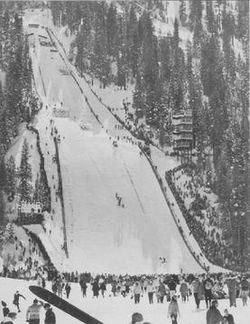Papoose Peak Jumps facts for kids
Quick facts for kids Papoose Peak Jumps |
|
|---|---|
 |
|
| Location | Little Papoose Peak Squaw Valley United States |
| Opened | 1958 |
| Renovated | 1975 |
| Closed | 1976 |
| Demolished | Yes |
| Size | |
| K–point | K80 |
| Hill size | K80, K60, K40 |
| Hill record | Jim Denney (99.0 m in 1976) |
| Top events | |
| Olympics | 1960 |
The Papoose Peak Jumps was a special place for ski jumping located at Squaw Valley Ski Resort in California, United States. It had three different jumps, like giant slides, for skiers to launch themselves from. These jumps were built especially for the 1960 Winter Olympics. The biggest jump (80 meters) was used for the main ski jumping competition. A smaller one (60 meters) was used for an event called Nordic combined. A famous designer named Heini Klopfer helped create it, and it opened in 1958. After the Olympics, it wasn't used much. It was fixed up for a competition in 1976, but then it was taken down to make space for a ski lift.
The Story of the Jumps
When Squaw Valley was chosen to host the Olympics, it was mostly undeveloped land. This meant the organizers could design everything exactly how they wanted! They hired Heini Klopfer, a skilled designer from West Germany, to plan the ski jumps. He finished his plans in early 1957.
He chose a perfect spot on the side of Little Papoose Peak. It was right across from another Olympic building called Blyth Arena. Klopfer even said it was "the type of hill one always seeks but seldom finds" because it was so good. Construction of the jumps began in the summer and fall of 1958.
The Papoose Peak Jumps were special because they were the first Olympic ski jumps to have three different starting ramps. Small improvements were made in 1959 and 1960. The jumps were later renovated for the 1976 US National Ski Jumping Championships. However, after that, they weren't used much. The hill was later changed to be used for speed skiing and snowboarding. Eventually, the resort's Far East Express chairlift was built on the same hill.
What the Jumps Were Like
The Papoose Peak Jumps had three different sizes of jumps. They all shared the same landing area. The jumps had "K-points" (a way to measure their size) of 80, 60, and 40 meters.
The jumps were located right in the middle of the Olympic resort. They were next to the skating rinks and the Olympic Village. Tall trees on both sides of the hill helped protect the jumpers from strong winds. The location was also great because the sun was behind the athletes, so they weren't looking into the glare.
A special tower for the judges was built on the side of the hill. Judges could reach it by stairs from the bottom or by a chairlift that went to the top of the jumps. The entire hill was about 140 meters (460 feet) tall. The starting ramp for the biggest jump was 113 meters (371 feet) long. The biggest jump had a take-off angle of 8.5 degrees and a landing angle of 38 degrees.
Competitions Held Here
The first time the jumps were used in a competition was for the trial Olympics in February 1959.
During the 1960 Winter Olympics:
- The 80-meter hill was used for the main ski jumping event on February 28.
- The 60-meter hill was used for the ski jumping part of the Nordic combined event on February 22.
In the special ski jumping event, Helmut Recknagel from Germany won the gold medal. He also set a new hill record by jumping 93.5 meters (307 feet)! Niilo Halonen from Finland came in second, and Otto Leodolter from Austria was third.
In the Nordic combined event, Georg Thoma from Germany scored the most points in the ski jumping part. He was followed by Dmitriy Kochkin from the Soviet Union and Tormod Knutsen from Norway. The cross-country skiing part of this event happened at McKinney Creek Stadium. While Thoma won the overall Nordic combined event, Knutsen finished second overall, and Nikolai Gusakov from the Soviet Union was third.
In 1976, the US National Championships in Ski Jumping were held on the large hill. Jim Denney won this competition.

